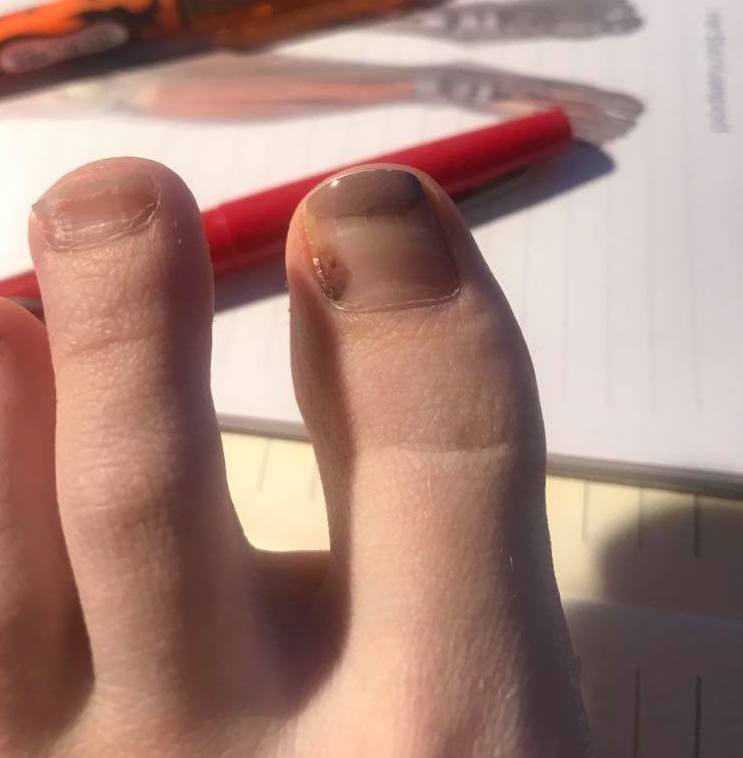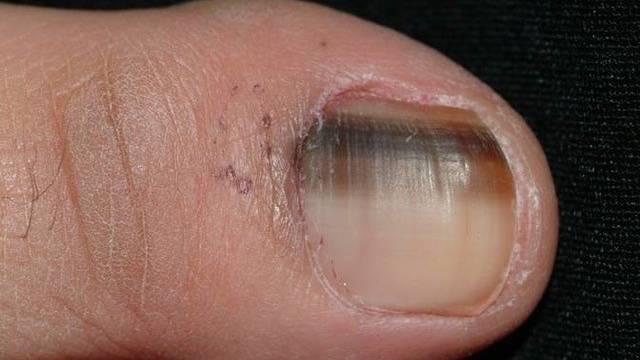
29 Sep The Brown Spot On Your Nail: A Melanoma Or A Simple Bleed?
While you may best know Bob Marley for ‘no woman no cry’, among many other hits, in the podiatry world we also remember him from the melanoma that started as a brown spot on his toenail that led to a four-year battle and ultimately his death. A melanoma that could have been completely preventable if caught early.
First thing’s first: let’s make sure we’re all on the same page.
Melanoma: a potentially serious type of skin cancer, where the cells responsible for our skin’s pigment, grow and spread uncontrollably. Yep, this is the one that can start as a simple mole or spot – though with the example we’re talking about today, it’s beneath your toenail.
The hard bit here is that when you stub your toe, kick the ball too hard, go skiing in tight boots, or don’t trim your toenails for a few months and then go on a hike (speaking from experience), you can get a small bleed beneath your toenail – like this one, from one of our team here.
What do you look for in a melanoma beneath the toenail?
Our simplest answer is that if you notice something new, or the spot beneath your nail is changing, always get it checked out. It’s just not worth the risk to not.
Specifically, look for ugly ducklings – compare the mole – or as much as you can discern about it from beneath your toenail, in relation to your other moles. Most moles will look fairly similar, while melanomas tend to stand out in comparison.
Look for changes in your existing mole, or the appearance of a new mole. This stands true whether it’s beneath the nail or not. 70% of melanomas arise as new moles, and 30% from pre-existing ones that start to change over time.
Here’s a helpful memory and recognition tool that we use as podiatrists – ABCDE
 A – Asymmetry – most melanomas are asymmetrical
A – Asymmetry – most melanomas are asymmetrical
B – Border irregularity – the borders of most melanomas are irregularly shaped
C – Colour variation – more than two colours in a lesion is a warning sign
D – Diameter over 6mm
E – Evolving – you’re noticing any changes in the mole including shape, size and colour
How are melanomas diagnosed?
Melanoma is diagnosed after physical exam and biopsy. A tool called a dermatoscope can be used to triage skin lesions. It magnifies the lesion and makes it possible to see the different patterns and colours that may not be visible to the naked eye. The dermatoscope is non-invasive and painless.
Where do melanomas occur on the foot aside from the nail?
A melanoma can occur literally anywhere on the feet or legs. Never rule a melanoma out based on its location.
Why is it important to get it checked out?
Melanomas can grow very quickly and spread to other parts of the body if left untreated. Your best chance of a full recovery is with an early diagnosis.
Who do melanomas tend to affect?
Melanomas can develop anywhere and on anyone. While they are most likely to develop in areas that have had exposure to the sun, they also can develop in places that don’t such as the soles of your feet.
Factors that increase risk of developing melanoma include:
- Increased exposure to UV light
- Fair skin, those with lighter complexion have a greater risk than those with a darker complexion – though all ethnic groups and skin types can be affected
- Family history and genetics
- Weakened immune system
- Increased number of moles – the more you have, the higher the melanoma risk
Remember, new moles appearing in middle and older age are much less common – most appear in early years.
I’m concerned about a spot beneath my nail or on my foot. What should I do?
If you’re unsure if the spot on your foot is from a melanoma or something else and you’d like it checked before heading to the dermatologist, our podiatrist, Jess, has just completed her advanced dermatology course. She can let you know whether your discolouration is likely to be from your weekend ski trip, or further investigation is needed.
Book your appointment with her by calling us on 06 370 4057 or book your appointment online here.


